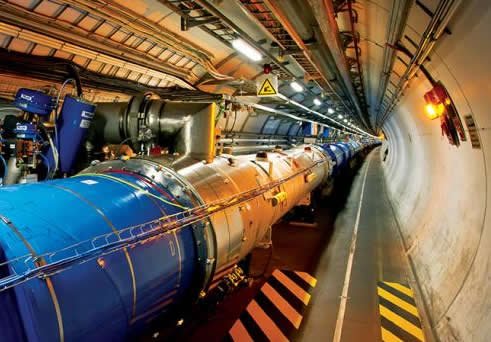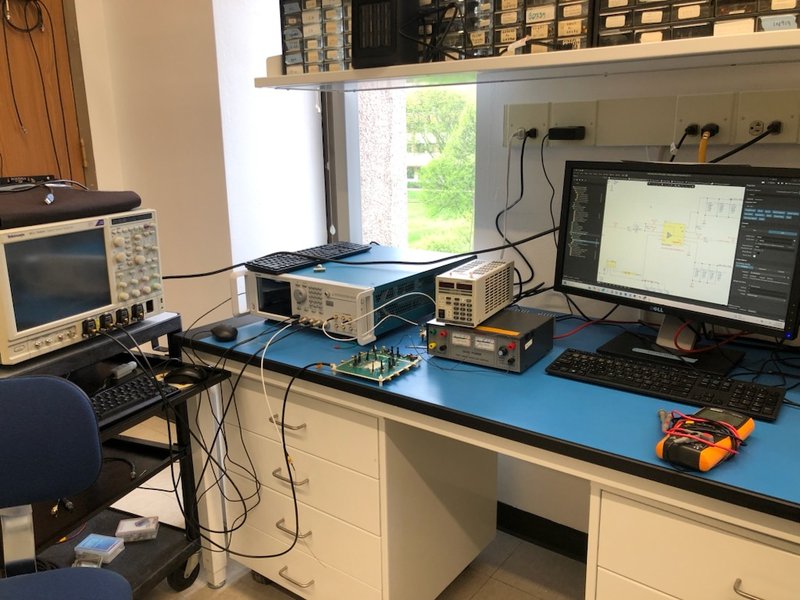
Editor’s Note: The following article was written by Antara Paul (pictured), a graduate student in the Department of Physics at Syracuse University.
In an electronics lab in the Physics Building, graduate student Bridget Mack from the LHCb group is usually found studying tiny silicon sensors about the size of a fingernail. These sensors, called low-gain avalanche diodes or LGADs, when hit with a high-powered laser, produce electric signals. She is looking for this signal to have a high resolution to measure the exact time that the photons from the laser hit the sensor. As this sharpness depends on the sensor’s size, thickness and fabrication, she tests different parameters to understand how the material works and how best to use it for particle detectors in decades to come.

This is just one example of what a typical day for a particle physicist might look like. Others might be building electronics or analyzing physics data recorded by detectors. In the LHCb group at Syracuse University, researchers work on various aspects of the construction and maintenance of the LHCb detector. The technologies developed through this R&D can be used for detectors beyond LHCb as well.
But what exactly is the LHCb detector? Three hundred thirty feet under the Switzerland-France border at CERN lies the circular Large Hadron Collider (LHC) (pictured below) which accelerates and collides particles like protons to study fundamental physics that govern our universe. LHCb is one of the four major detectors at the LHC, where the b stands for ‘beauty’. While the detector itself is an enormous structure — measuring 68 ft by 33 ft by 42 ft — it studies minuscule particles invisible to the naked eye. The group at SU is one of the many research groups that is a part of this worldwide collaboration.

When two beams of protons collide head-on, their interaction results in a series of decays which produce cascades of different particles flying out in every direction. Protons are made up of smaller, fundamental particles called up and down quarks — two of the six known types of quarks. When collided at high energy, they can produce heavier quarks like the b (beauty) and c (charm) quarks. The LHCb detector studies the physics of these rare particles (hence the ‘b’ in its name). The detector is constructed with its sub-detectors stacked one behind the other and they work collectively to ‘capture the images’ of different particles produced as they keep moving forward.
To increase the chances of occurrences of rare physics phenomena, multiple proton bunches are collided 40 million times per second. This leads to an extremely high number of particles that the detector captures and filters to find interesting physics signals. Different sub-detectors measure the energy, momentum and identity of the millions of particles, and they have to do it fast enough to separate them from particles produced by the next wave of collisions. Every few years, the detector components are upgraded to keep up with detecting increasing number of particles fast and precisely. Mack’s work on LGADs is to create a future "5d" detector that, along with position and energy, can also measure time of arrival of particles with precision.
The construction of advanced detector material is complemented with fast electronics that can transmit signals from detectors to computers accurately for analysis. With LHCb’s upcoming major upgrade, the SU group is specifically working on the Electromagnetic Calorimeter (ECal) — the sub-detector that measures the energy of photons and charged particles like electrons. The ECal is made up of multiple small cells. When a particle stops in the Ecal, it deposits all its energy to one or more cells, from the sum of which the particle’s energy is assigned. As more particles are stopped in these cells after the upgrade, it will be hard to differentiate between energy deposits from different particles.
The electrical signals from the deposits are converted to digital signals using a special chip called waveform sampling Application-Specific Integrated Circuit (ASIC). These ASICs are installed on fast-readout electronics boards that are being designed and tested by graduate students Lauren Mackey and Andrew Dowling.

An electronics board being tested in a lab inside the Physics Building.
It is important for the entire setup to have a fast response so they can transmit complete information of each pulse quickly. Additionally, Mackey is researching specialized devices to record the exact time a signal hits a cell to make the overall measurement more precise.
This data will be processed in the computer using a machine learning (ML) algorithm. Justin Bartz, another graduate student in the group, is training one such algorithm called a Graph Neural Network (GNN) on simulated signals. He is training the GNN to learn how the amount of energy in one cell is related to the energy in another, or how a particle's energy is shared between different cells. Once proved feasible, this approach could be used on the actual data from ECal to separate the energy deposits of nearby particles. Thus, from studying sensor materials to identifying data for physics analysis, group members work on different stages of detector development.
The ongoing work is aimed at an upgrade that will take place in the 2030s. While this might seem far off, particle physicists are already ramping up efforts to develop these advanced detector technologies. It takes decades of research and collaboration of scientists across continents to build such particle detectors. These technologies go beyond the scope of particle physics — from hardware that powers medical imaging to ML algorithms tackling real-world issues like fraud detection. So, while a physicist buried in their computer might seem to be solving an obscure physics problem, their solutions could bring in technologies that would benefit people outside physics labs.
